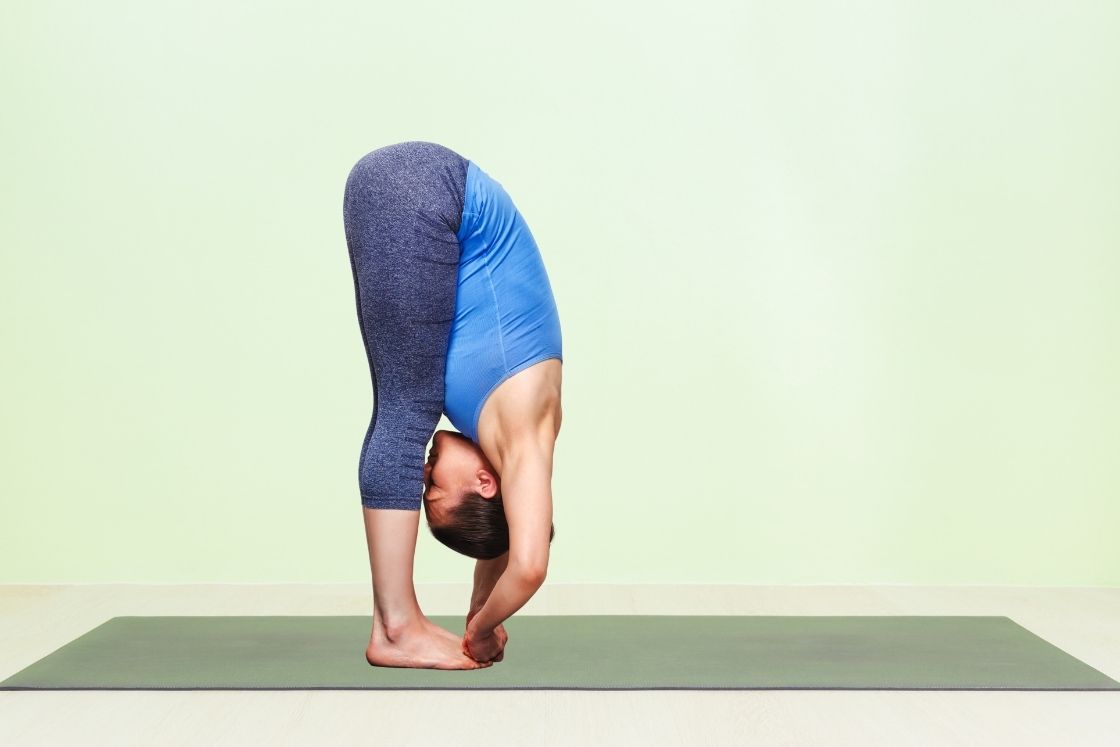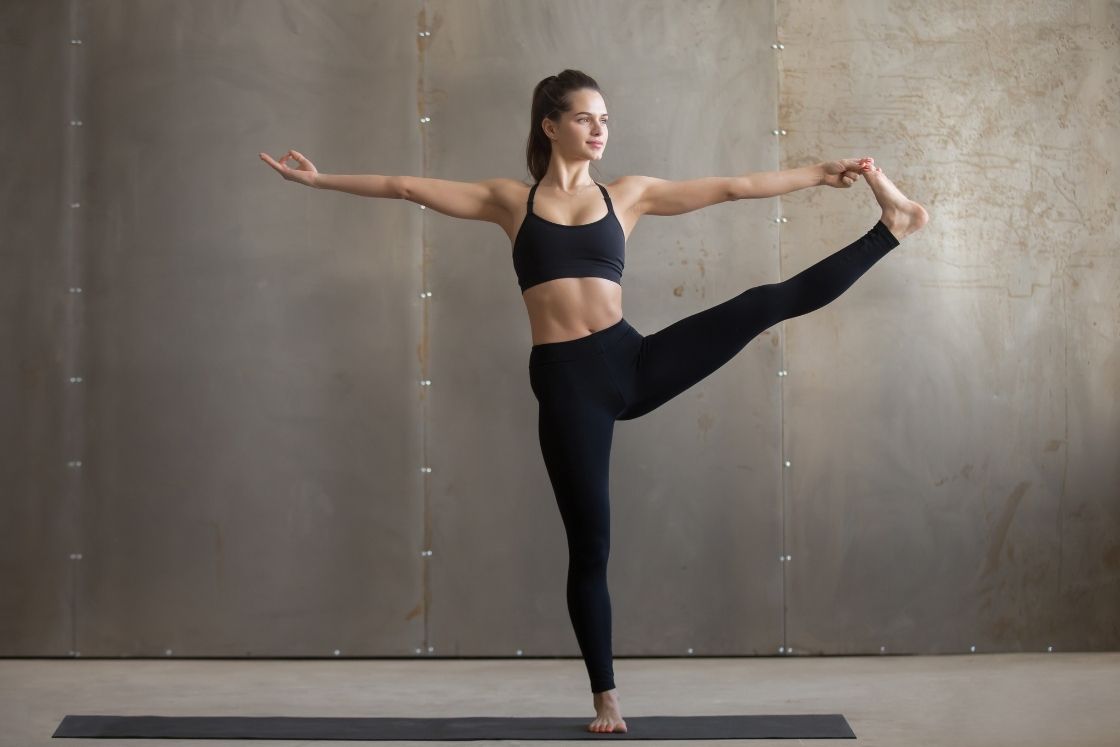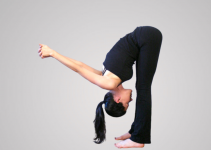
Padangusthasana is one of the fundamental asanas of Ashtanga Yoga. It is a simple standing pose that involves forward bending. As per its ease, the asana comes under the beginner level.
Padangusthasana targets every muscle in the body by providing a deep stretch from head to toe. It releases tension from the body and relieves pain. Along with its various benefits, it is therapeutic for flat feet.
If you are about to start your yoga journey then padangusthasana is an ideal pose to begin with.
Meaning
The term ‘padangusthasana’ is taken from Sanskrit. It is composed of the following root words:
- ‘In Sanskrit, ‘pada’ means ‘foot’
- ‘Angustha’ is ‘big toe’
- ‘Asana’ refers to ‘pose’
These terms are enough to express the literal meaning of the posture. It is all about grabbing the big toe with the hands with bending forward.

However, in Bikram yoga padangusthasana is not exactly the same but it’s a balancing posture out of 26 poses of Bikram yoga. In big toe pose in Bikram yoga, you hold the body on the big toe while sitting squat pose.
Padangusthasana Practice Guide
Go through the following points to practice Padangusthasana easily & safely.
Precautions & Contraindications
- Lower back injury– Avoid practicing padangusthasana if you have a lower back injury. The pose intensely stretches the spine and practicing it along with an injury will intensify the pain.
- Neck injury- Do not perform the pose with the broken neck.
- Pregnancy– The pose is not recommended to pregnant women as it exerts pressure to lower back and abdomen.
- Perform the asana by accepting your body’s limit. Do not push yourself at one go. Increase the limits gradually and reach the pose to its maximum.
Preparatory poses
- Standing Forward Bend (Uttanasana)
- Seated Forward Bend (Paschimottanasana)
- Reclining Hand-to-Big-Toe Pose (Supta Pandangusthasana)
- Downward-facing Dog Pose (Adho Mukha Shvanasana)
Padangusthasana Steps
- Stand tall with the feet six inches apart.
- Straighten your legs with the kneecaps lifted and bring the hands at the waistline.
- Exhale and bend forward from the hip joints keeping your spine and legs straight.
- Firmly grab the big toes using the thumb, index, and middle finger with your palms facing each other.
- Keep the hands straight and look forward.
- Inhale and draw your elbows outwards stretching the shoulder blades.
- As you exhale fold deeper and bring your head between the knees pulling the body towards the toes.
- Keep breathing and maintain the pose for almost 20 seconds.
- Inhale lifting the head and chest halfway.
- Exhale and bring your hands to the waistline.
- Inhale and come up straight bringing the feet together.
Beginners find the pose challenging when it comes to holding the big toe. It is advisable to maintain the pose keeping the hands to the calves or thighs. Ensure to keep your knees straight all through.
Follow up poses
- Chair Pose (Utkatasana)
- Triangle Pose (Trikonasana)
Modifications & Variations
The base big toe pose can be modified to simplify it:
Using yoga strap – A yoga strap can be used as a prop to modify the pose. Make a loop out of the strap and place it under the arch for easily holding the pose without bending knees.
These variations can be practiced along with Padangusthasana.
1. Utthita Hasta Padangusthasana

After attaining padangusthasana fully, it is recommended to try its advanced variation, i.e. Utthita Hasta Padangusthasana. It is performed by standing upright, lifting, and stretching one leg to the side. Then, reach the big toe with the respective hand.
2. Standing Fire Hydrant Pose
Here, after reaching the toes by both hands (fingers) start lifting one leg with the hand and stretch it to the side, while keep holding the opposite big toe. Keep the hands and legs straight while maintaining the pose.
Padangusthasana Benefits
1. Provides flexibility
It is a posture that involves deep stretch in the calves and hamstrings. Besides this, the entire body feels stretched while maintaining the pose that ultimately results in making the body flexible.
2. Stimulates abdominal region
During the forward bend, the abdominal muscles are pressurized and get activated. This, in turn, improves the functioning of the digestive system.
3. Activates endocrine system
The forward fold stimulates the pancreas, pineal, pituitary, thyroid, and adrenal glands. It keeps the hormonal balance in the body. There is a supportive study that concludes that proper hormonal secretion maintains the homeostasis of the body.
4. Stimulates reproductive organs
Padangusthasana improves the functioning of reproductive organs including ovaries, uterus, testes, etc. This boosts the reproductive system.
5. Cures insomnia
The pose helps in the circulation of fresh blood to the brain providing calmness and prepares the body for sound sleep.
6. Reduces anxiety and stress
The forward fold enhances the blood circulation thereby increasing the energy level and diminishing the tendency to get anxious. Padangusthasana is followed with gentle breathing that relieves the tension trapped within the body.
According to a study [efn_note] Effect of Yoga Practices on Occupational Stress among Indian Army Personnel http://www.dsvv.ac.in/wp-content/uploads/dsvv/2011/02/rajuadhikari.pdf [/efn_note] it is proved that this asana is beneficial to get rid of occupational stress.
7. Relieving action during menstruation
Big toe pose is beneficial for women suffering from PMS [efn_note] Effects of yoga on quality of sleep of women with premenstrual syndrome https://www.researchgate.net/publication/324774664_Effects_of_yoga_on_quality_of_sleep_of_women_with_premenstrual_syndrome [/efn_note]. The menstrual cramps can be mitigated by practicing padangusthasana. It is even helpful in relieves the symptoms of menopause.
8. Benefits kidney, liver, and spleen
The asana also has a stimulating action on the kidney, liver, and spleen. It helps in maintaining the metabolism of the body and keeps the immune system strong.
9. Strengthens and tones the muscles
The leg muscles at the hamstrings and calves get toned with its practicing. The thighs and legs become strong.
10. Cures flat foot
During the pose, the feet are kept firm on the floor. It stretches and lengthens the feet. It also helps in developing an arch that eventually provides comfort while walking and eliminates the elements of flat foot.
Conclusion
Begin your yoga journey for a stress-free living with Padangusthasana. The pose is easy to get started and offers a lot of variations to explore. Keeping the health benefits in view especially for today’s busy and stressed lifestyle the pose is a must to try on.




